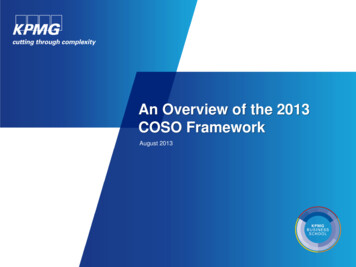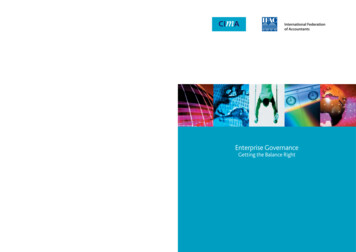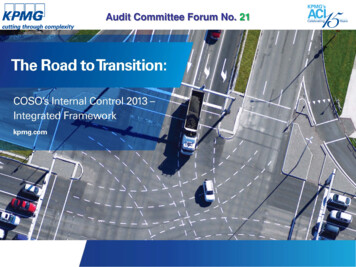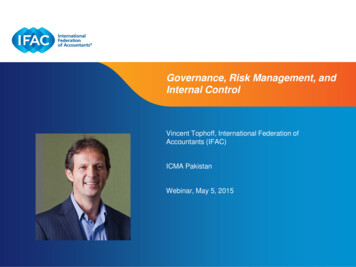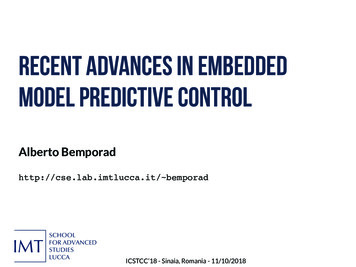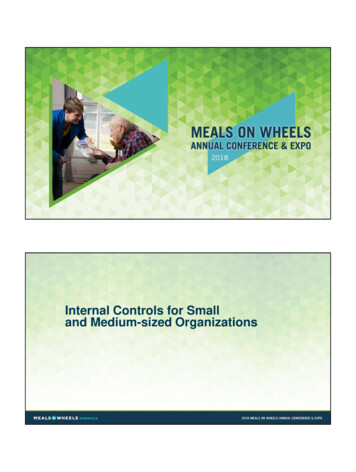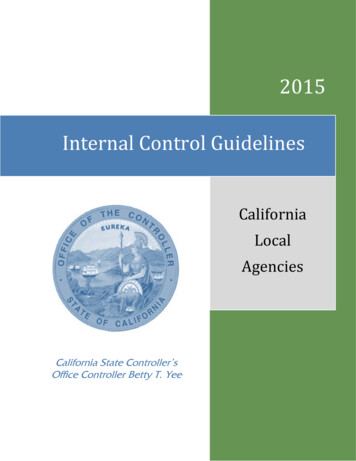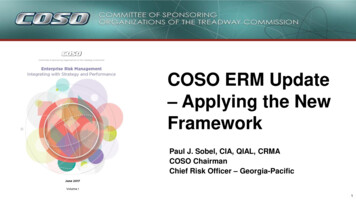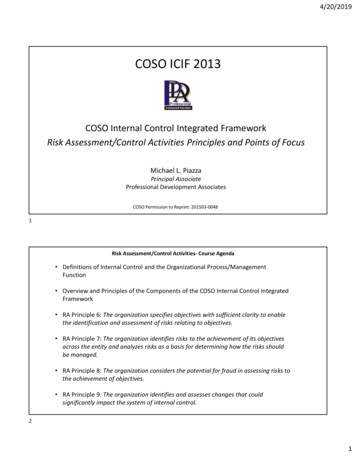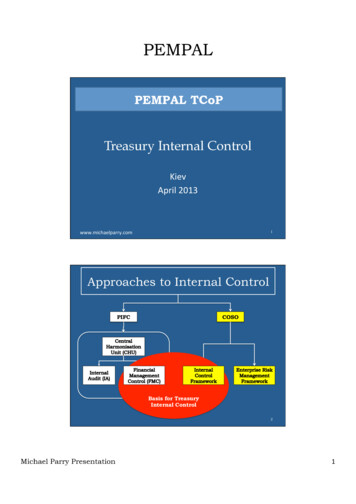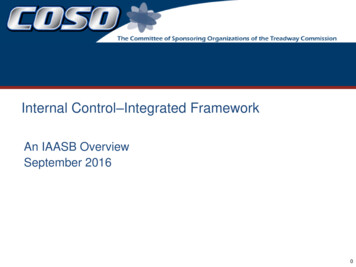
Transcription
Internal Control–Integrated FrameworkAn IAASB OverviewSeptember 20160
Table of Contents COSO & Project Overview Internal Control-Integrated Framework Illustrative Documents– Illustrative Tools for Assessing Effectiveness of a System of Internal Control– Internal Control over External Financial Reporting: A Compendium ofApproaches and examples Transition & Impact Recommended Actions Questions1
COSO & Project Overview2
Originally formed in 1985, COSO is a joint initiative of five privatesector organizations and is dedicated to providing thought leadershipthrough the development of frameworks and guidance on enterpriserisk management (ERM) internal control and fraud deterrence.9,300386,00015,000 600,00067,000180,0003
COSO Overview – Internal Control Publications19922006200920134
Why update what works – The Framework has become themost widely adopted control framework �s Internal Control–Integrated Framework (1992 Edition)Reflect changes inExpand operations andArticulate principles tobusiness & operatingreporting objectivesfacilitate pdatesContextinternal controlBroadens ApplicationClarifies RequirementsCOSO’s Internal Control–Integrated Framework (2013 Edition)5
Project timetableAssess & SurveyStakeholdersDesign & Build20102011Public Exposure,Assess & Refine2012Finalize20136
Project participantsCOSOBoard of DirectorsPwCAuthor &Project LeaderCOSO Advisory CouncilStakeholders Over 700 stakeholders in Frameworkresponded to global survey during 2011AICPAAAAFEIIIAIMAPublic Accounting FirmsRegulatory observers (SEC, GAO, FDIC,PCAOB) Others (IFAC, ISACA, others) Over 200 stakeholders publically commentedon proposed updates to Framework duringfirst quarter of 2012 Over 50 stakeholders publically commented onproposed updates in last quarter of 20127
Project deliverable #1 – Internal Control-IntegratedFramework (2013 Edition) Consists of three volumes: Executive Summary Framework and Appendices Illustrative Tools forAssessing Effectiveness of aSystem of Internal Control Sets out: Definition of internal control Categories of objectives Components of internalcontrol Requirements foreffectiveness8
Project deliverable #2 – Internal Control over ExternalFinancial Reporting: A Compendium. Approaches and Examplesillustrate how principles areapplied in preparing financialstatements Considers changes inbusiness and operatingenvironments during past twodecades Relevant for variety of entities– public, private, not-for-profit,and government Consistent with updatedFramework9
Internal Control–Integrated Framework10
Update expected to ease use and applicationWhat is not changing.What is changing. Core definition of internal control Changes in business and operatingenvironments considered Three categories of objectives andfive components of internal control Each of the five components ofinternal control are required foreffective internal control Important role of judgment indesigning, implementing andconducting internal control, and inassessing its effectiveness Operations and reporting objectivesexpanded Fundamental concepts underlyingfive components articulated asprinciples Additional approaches andexamples relevant to operations,compliance, and non-financialreporting objectives added11
Update considers changes in business and operatingenvironmentsEnvironments changes. have driven Framework updatesExpectations for governance oversightGlobalization of markets and operationsChanges and greater complexity in businessDemands and complexities in laws, rules,regulations, and standardsExpectations for competencies andaccountabilitiesUse of, and reliance on, evolving technologiesExpectations relating to preventing anddetecting fraudCOSO Cube (2013Edition)12
Update articulates principles of effective internal controlControl EnvironmentRisk AssessmentControl ActivitiesInformation &CommunicationMonitoring Activities1.2.3.4.5.Demonstrates commitment to integrity and ethical valuesExercises oversight responsibilityEstablishes structure, authority and responsibilityDemonstrates commitment to competenceEnforces accountability6.7.8.9.Specifies suitable objectivesIdentifies and analyzes riskAssesses fraud riskIdentifies and analyzes significant change10. Selects and develops control activities11. Selects and develops general controls over technology12. Deploys through policies and procedures13. Uses relevant information14. Communicates internally15. Communicates externally16. Conducts ongoing and/or separate evaluations17. Evaluates and communicates deficiencies13
Update articulates principles of effective internal control(continued)Control Environment1. The organization demonstrates a commitment tointegrity and ethical values.2. The board of directors demonstrates independencefrom management and exercises oversight of thedevelopment and performance of internal control.3. Management establishes, with board oversight,structures, reporting lines, and appropriateauthorities and responsibilities in the pursuit ofobjectives.4. The organization demonstrates a commitment toattract, develop, and retain competent individualsin alignment with objectives.5. The organization holds individuals accountable fortheir internal control responsibilities in the pursuitof objectives.14
Update articulates principles of effective internal control(continued)Risk Assessment6. The organization specifies objectives withsufficient clarity to enable the identification andassessment of risks relating to objectives.7. The organization identifies risks to theachievement of its objectives across the entityand analyzes risks as a basis for determininghow the risks should be managed.8. The organization considers the potential forfraud in assessing risks to the achievement ofobjectives.9. The organization identifies and assesseschanges that could significantly impact thesystem of internal control.15
Update articulates principles of effective internal control(continued)Control Activities10. The organization selects and develops controlactivities that contribute to the mitigation of risksto the achievement of objectives to acceptablelevels.11. The organization selects and develops generalcontrol activities over technology to support theachievement of objectives.12. The organization deploys control activitiesthrough policies that establish what is expectedand procedures that put policies into place.16
Update articulates principles of effective internal control(continued)Information &Communication13. The organization obtains or generates and usesrelevant, quality information to support thefunctioning of other components of internalcontrol.14. The organization internally communicatesinformation, including objectives andresponsibilities for internal control, necessary tosupport the functioning of other components ofinternal control.15. The organization communicates with externalparties regarding matters affecting thefunctioning of other components of internalcontrol.17
Update articulates principles of effective internal control(continued)Monitoring Activities16. The organization selects, develops, andperforms ongoing and/or separate evaluationsto ascertain whether the components of internalcontrol are present and functioning.17. The organization evaluates and communicatesinternal control deficiencies in a timely mannerto those parties responsible for taking correctiveaction, including senior management and theboard of directors, as appropriate.18
Update clarifies requirements for effective internal control Effective internal control provides reasonable assurance regarding theachievement of objectives and requires that:– Each component and each relevant principle is present and functioning– The five components are operating together in an integrated manner Each principle is suitable to all entities; all principles are presumed relevantexcept in rare situations where management determines that a principle isnot relevant to a component (e.g., governance, technology) Components operate together when all components are present andfunctioning and internal control deficiencies aggregated across componentsdo not result in one or more major deficiencies A major deficiency represents an internal control deficiency or combinationthereof that severely reduces the likelihood that an entity can achieve itsobjectives19
Update describes important characteristics of principles, forinstance.Control Environment1. The organization demonstrates a commitment tointegrity and ethical values.Points of Focus: Sets the Tone at the Top Establishes Standards of Conduct Evaluates Adherence to Standards of Conduct Addresses Deviations in a Timely Manner Points of focus may not be suitable or relevant, and others may be identified Points of focus may facilitate designing, implementing, and conducting internalcontrol There is no requirement to separately assess whether points of focus are inplace20
Update describes the role of controls to effect principles Embedded within the internal control process are controls, which consist ofpolicies and procedures. Policies reflect management or board statements ofwhat should be done to effect control. Procedures are actions that implementpolicies. Organizations select and develop controls within each component toeffect relevant principles. The Framework does not prescribe controls to be selected, developed, anddeployed for effective internal control An organization’s selection of controls to effect relevant principles andassociated components is a function of management judgment based on factorsunique to the entity A major deficiency in a component or principle cannot be mitigated to anacceptable level by the presence and functioning of other components andprinciples However, understanding and considering how controls effect multiple principlescan provide persuasive evidence supporting management’s assessment ofwhether components and relevant principles are present and functioning21
Update describes the role of controls to effect principlesComponentPrincipleControls effectmultipleprinciplesControl Environment1. The organization demonstrates a commitment to integrity andethical values.Human Resourcesreviews allemployees’ annualconfirmations toassess whetherstandards ofconduct areunderstood andadhered to(Principle 1)Managementreviews potentialdeviations capturedthrough thewhistleblower hotline and theunderlying data andinformation(Principle 13)Internal Auditseparately evaluatesthe controlenvironment,consideringemployee behaviorsand whistleblowerhotline results andreports thereon(Principles 16 & 17)22
Summary of public exposure of proposed update Interest across geographic regions – approximately 50% of respondentsfrom North America and 50% from international regions Proposed updates to Framework released for public comments:– December 20, 2011 to March 31, 2012– September 18, 2012 to December 4, 2012 COSO sought comments from the general public on proposed updates,including whether the:– Requirements of effective internal control are clearly set forth– Roles of components, principles, and points of focus are clearly set forth– Framework remains sound, logical, and useful to management of entities ofall types and sizes Public comment letters available at www.ic.coso.org until Dec. 31, 201323
Updates are responsive to public comments Principles– Provide clarity regarding the role of principles in designing, implementing, andconducting internal control, and assessing its effectiveness– Clarify descriptions of some principles, but no additional principles Effectiveness– Recognize effective internal control can provide reasonable assurance ofachieving effective and efficient operations objectives (as noted before)– Clarify requirement that each of the components and relevant principles mustbe present and functioning and components must operating together– Remove presumption that points of focus are present and functioning, andclarify that no separate assessment of points of focus is required– Standardize classification of internal control deficiencies, and clarify use ofonly relevant criteria established in laws, rules, regulations and standards24
Updates are responsive to public comments (continued) Objective Setting– Retain five components of internal control– Retain specification of objectives as a principle of effective internal control,but objective setting may be driven by laws, rules, regulations ,or externalstandards that are outside a system of internal control Objectives– Retain view that safeguarding of assets primarily relates to operationsobjectives, and recognize its consideration within reporting and compliance– Acknowledge some laws rules, regulations and standards establishsafeguarding of assets as a separate category of objectives– Retain view that strategic objectives is not part of internal control– Retain operations, reporting, and compliance objective categories, andexpand descriptions25
Updates are responsive to public comments (continued) Enterprise Risk Management (ERM)– Retain distinction between ERM and internal control, and acknowledge theseframeworks are complementary– Retain view that strategy-setting, strategic objectives, and risk appetite areaspects of ERM, not Internal Control-Integrated Framework– Retain discussion of risk appetite and application of risk tolerance Smaller Entities and Governments – Provide additional guidance specific tosmaller entities and governments (Appendix C) Technology– Expand discussion in the points of focus and in several chapters– Decline suggestion to address risk associated with specific technologiesbecause of the rapid pace of change26
Updates are responsive to public comments (continued) Structure and Layout – Retain view that all chapters 1-10 comprise theFramework Due Process – COSO believes there has been a substantive due processeffort to capture views on proposed update– Surveyed stakeholders to ascertain preferences concerning nature andextent of needed updates; 700 responses (December 2010 to September2011)– Conducted eleven meetings with COSO Advisory Council– Provided exposure drafts of proposed updates for public comments(December 2011 to March 2012, and September to December 2012)– Participated in many conferences, webinars, and seminars with membershipof COSO to seek views of stakeholders (January 2011 to January 2013)27
Illustrative Documents:- Illustrative Tools for Assessing Effectiveness of a System of InternalControl- Internal Control over External Financial Reporting: A Compendium ofApproaches and Examples28
Illustrative Tools for Assessing Effectiveness of a System ofInternal Control Assist users when assessing effectiveness of internal control based on therequirements set forth in the Framework– Templates illustrate a possible summary of assessment results– Scenarios illustrate practical examples of how the templates can be used tosupport an assessment and important considerations in performing anassessment Focus on evaluating components and relevant principles, not the underlyingcontrols that affect relevant principles Cannot satisfy criteria established through laws, rules, regulations, orexternal standards for evaluating the severity of internal control deficiencies Can customize level and amount of detail included in the templates asmanagement may deem necessary29
Internal Control over External Financial Reporting (ICEFR):A Compendium of Approaches and Examples Approaches and Examples illustrate how various characteristics ofprinciples may be present and functioning within a system of internal controlrelating to external financial reporting– Approaches are designed to give a summary-level description of activitiesthat management may consider as they apply the Framework– Examples illustrate one or more points of focus of a particular principle. Theyare not designed to provide a comprehensive, end-to-end example of how aprinciple may be fully applied in practice.– Selected approaches and examples do not illustrate all aspects ofcomponents and relevant principles that would be necessary for effectiveinternal control Stakeholders should refer to the Framework for the requirements ofeffective internal control Compendium supplements and can be used in concert30
Illustrative documents are responsive to public comments ICEFR: A Compendium of Approaches and Examples– Add or clarify specific examples, including: Establishing responsibilities for reviewing financial statements Monitoring investigation and reporting of whistleblower allegations Monitoring identification and protection of sensitive financial information Monitoring identification and analysis of risk of material misstatement due tofraud– Address a risk-based approach for achieving external financial reportingobjectives Specify suitable objectives for external financial reporting Risks to achieving suitable objectives Responses to risks31
Questions & Comments32
Framework COSO'sInternal Control-Integrated Framework (2013 Edition) Broadens Application Clarifies Requirements Articulate principles to facilitate effective internal control Why update what works -The Framework has become the most widely adopted control framework worldwide. Updates Context Enhancements Reflect changes in business .
